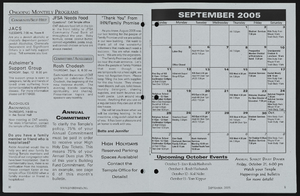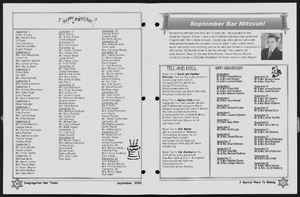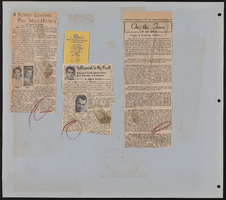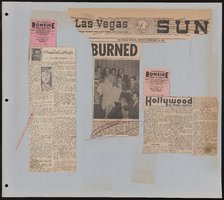Search the Special Collections and Archives Portal
Search Results
The Whitney Family Collection of Bunkerville, Nevada Photographs
Identifier
Abstract
The Whitney Family Collection of Bunkerville, Nevada Photographs (approximately 1900-1930) consists of black-and-white photographic prints and negatives depicting Agnes Murphy Neve, Luke Whitney, Julia Whitney, and Alfred Syphus near the Whitney family ranch in Bunkerville, Nevada. One image portrays an overflow drainage pipe connected to the St. Thomas pond near Bunkerville, Nevada.
Archival Collection
William White Postcard Collection
Identifier
Abstract
The William White Postcard Collection (approximately 1930-1940) consists of three postcards depicting the Hoover Dam (Boulder Dam) on the border of Nevada and Arizona. One postcard showcases Oskar J. W. Hansen’s “Figures of the Republic” sculptures near the Hoover Dam. Another postcard displays an interior view of the visitor’s gallery at the Hoover Dam. The final postcard depicts the Hoover Dam at sunset.
Archival Collection

Jack Weinstein and Polly Weinstein interview, April 12, 2018: transcript
Date
Archival Collection
Description
Tower of Jewels is one of those iconic Las Vegas businesses that continues to thrive. At the time of this interview, Jack Weinstein is in his nineties and “retired.” With him is his daughter Polly Weinstein, who in addition to being involved in the business management has her own custom designed jewelry line, aptly named The Jeweler’s Daughter. As the youngest of six children born to Jewish Russian immigrants Joseph and Pauline (Polly is named for her grandmother), Jack was raised in a dangerous neighborhood of Detroit, Michigan. His youthful enterprise included collaborating and then splitting up with his brothers in a jewelry business, before eventually moving west to Los Angles in the early 1960s. On his own, Jack became a wholesale salesperson representing lines of watches to other businesses. Included in his list of clients was Al Sanford’s Tower of Jewels in Las Vegas. The two became friends and Al suggested setting up a partnership between Al’s son and Jack in 1964. Eventually
Text

Transcript of interview with Mindy Unger-Wadkins by Barbara Tabach, October 28, 2015
Date
Archival Collection
Description
In this interview, Unger-Wadkins discusses growing up in Las Vegas? close-knit Jewish community in the 1960s and 1970s, and involvement with various Jewish youth organizations and activities. She also describes her career in public relations, reflecting upon the unique challenges faced when interacting with the public, and with politics, in her positions. Unger-Wadkins ends by describing her current work in land development, particularly the history of the Three Kids Mine and the technical and political process of ensuring the land is suitable as a residential area.
Text
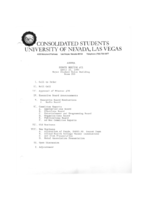
Meeting minutes for Consolidated Student Senate, University of Nevada, Las Vegas, October 14, 1980
Date
Archival Collection
Description
Text

